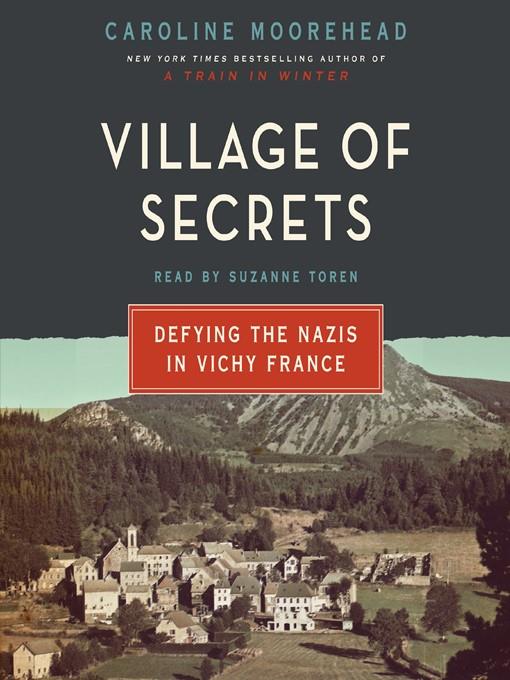
Village of Secrets
Defying the Nazis in Vichy France
کتاب های مرتبط
- اطلاعات
- نقد و بررسی
- دیدگاه کاربران
نقد و بررسی

Documenting bravery in an isolated corner of France, Suzanne Toren narrates with clarity and authority. The story of Le Chambon-sur-Lignon, in the mountains of the southern Massif Central in France, is one of courage, compassion, and some controversy. It's called "the village with a conscience" because between 1940 and 1944, the villagers, primarily Protestants, hid 800 Jews and helped nearly 3,000 Jews and others escape to Switzerland. Toren pronounces French surnames and place names smoothly and accurately. As is the case with all history that relies on personal diaries and aging memories, researchers disagree on details, but Moorehead's version of events is compelling. D.L.G. © AudioFile 2015, Portland, Maine

August 18, 2014
British historian and biographer Moorehead (A Train in Winter) offers an informative, comprehensive, and nuanced account of why and how the French village of Le Chambon-sur-Lignon hid hundreds of Jews during the Holocaust. Moorehead addresses the agonies mothers suffered at the French internment camps of Gurs and Rivesaltes when they gave up their children to be hidden; the fact that, as early as the fall of 1942, flyers in Paris concerning the deportation of Jews “spoke of the gassing of the weak and elderly”; and the role of the Darbyists, an austere, evangelical Protestant sect, in the hiding of Jews. Moorehead introduces readers to courageous rescuers both in Le Chambon and the surrounding region: Protestant pastor André Trocmé; master document-forger Oscar Rosowsky; and Moussa Abadi, a Syrian Jew who befriended the bishop of Nice (from whom he obtained an office to forge life-saving documents). She also covers the German capture of key individuals such as Madeleine Dreyfus, who helped Jewish children find refuge, and examines the ambiguous role played figures such as Major Schmähling, who commanded the local German garrison. Moorehead’s deeply researched, crisply written, and well-paced work will stand as the definitive account of a heroic, hazardous, and uplifting initiative during the German occupation. B&w photos

Starred review from October 15, 2014
For the small village of Le Chambon-sur-Lignon, World War II was both a terrifying and exhilarating time. Living in the remote mountainous region of eastern France, the village's historically Huguenot population was not unfamiliar with religious persecution. When the dispossessed of Europe--including Jewish refugees and orphans, as well as escaping prisoners of war and French Resistance fighters--began, in 1942, to find their way to Le Chambon and its environs, they found protection and safety from Nazi capture. Protestant pastors and villagers provided fugitives with shelter, schooling, food, false identities, secure hiding places, and occasional escape to Switzerland. Because of its extraordinary bravery, the village is recognized by Yad Vashem, the World Center for Holocaust Research, as one of their "Righteous Among Nations." Based on interviews with survivors and relatives and extensive archival research, activist Morehead (A Train in Winter) skillfully describes both the "felicitous combination of timing, place and people" in addition to the myth that has grown up around the events that took place there. VERDICT An exciting history of nearly forgotten individual and group courage. Highly recommended.--Linda Frederiksen, Washington State Univ. Lib., Vancouver
Copyright 2014 Library Journal, LLC Used with permission.

August 1, 2014
Moorehead (A Train in Winter: An Extraordinary Story of Women, Friendship, and Resistance in Occupied France, 2011) recounts the story of a small area in eastern France where opposition to the Nazis succeeded for years. In and around the small village of Le Chambon-sur-Lignon in the mountains of Ardeche, the residents were led in their "remarkable adventure in imagination and cooperation" by one man in particular, Pastor Andre Trocme. If not for the pastor, his family and his fellow citizens in the surrounding parishes, so many could never have been hidden and saved. They were descendants of the Huguenots whose history of modesty and silence enabled them to keep a secret and to keep to themselves. As Trocme delivered his fiery sermons, he also instigated the nonviolent resistance to the oppressors. The remarkable part of this story is how many people were involved in saving not only Jews or French, but anyone on the Nazi's list of "terrorists." The pastors, the farmers who took in refugees, the forgers who created ration books and passports, and the passeurs who guided people through the mountains-all were aided by the mayor and the prefect, who looked the other way and even warned of danger. Even when 170 convalescing German soldiers were sent to the village, not a word was spread about their arrival. This is a wonderful story of the people of more than 20 communes who saved more refugees, proportionately, than anywhere else in France. Hundreds were hidden and saved, and many thousands passed through. It's proof that the smallest gestures can often make the biggest difference. While celebrating the courage and sacrifice involved, the author also examines the often contentious dynamics behind the history and its legacy. Moorehead's knowledge of the people, the area and the history make this one of the most engrossing survival stories of World War II.
COPYRIGHT(2014) Kirkus Reviews, ALL RIGHTS RESERVED.

























دیدگاه کاربران